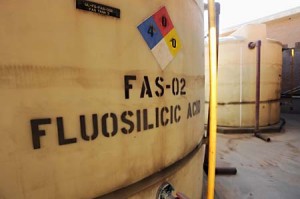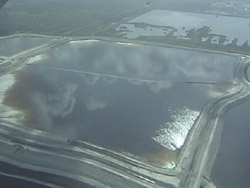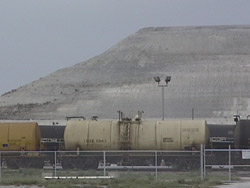1. Introduction
They call them “wet scrubbers” – the pollution control devices used by the phosphate industry to capture fluoride gases produced in the production of commercial fertilizer.
In the past, when the industry let these gases escape, vegetation became scorched, crops destroyed, and cattle crippled.
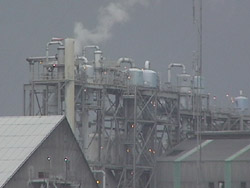
Today, with the development of sophisticated air-pollution control technology, less of the fluoride escapes into the atmosphere, and the type of pollution that threatened the survival of some communities in the 1950s and 60s, is but a thing of the past (at least in the US and other wealthy countries).
However, the impacts of the industry’s fluoride emissions are still being felt, although more subtly, by millions of people – people who, for the most part, do not live anywhere near a phosphate plant.
That’s because, after being captured in the scrubbers, the fluoride acid (hydrofluorosilicic acid), a classified hazardous waste, is barreled up and sold, unrefined, to communities across the country. Communities add hydrofluorosilicic acid to their water supplies as the primary fluoride chemical for water fluoridation.
Even if you don’t live in a community where fluoride is added to water, you’ll still be getting a dose of it through cereal, soda, juice, beer and any other processed food and drink manufactured with fluoridated water.
Meanwhile, if the phosphate industry has its way, it may soon be distributing another of its by-products to communities across the country. That waste product is radium, which may soon be added to a roadbed near you – if the EPA buckles and industry has its way.
2. Effects of Fluoride Pollution
Central Florida knows it well. So too does Garrison Montana, Cubatao Brazil, and any other community where phosphate industries have had inefficient, or non-existent, pollution control: Fluoride.
The Canadian Broadcasting Corporation (CBC) called the phosphate industry a “pandora’s box.” While the industry brought wealth to rural communities, it also brought ecological devastation. The CBC described the effects of one particular phosphate plant in Dunville, Ontario:
“Farmers noticed it first… Something mysterious burned the peppers, burned the fruit, dwarfed and shriveled the grains, damaged everything that grew. Something in the air destroyed the crops. Anyone could see it… They noticed it first in 1961. Again in ’62. Worse each year. Plants that didn’t burn, were dwarfed. Grain yields cut in half…Finally, a greater disaster revealed the source of the trouble. A plume from a silver stack, once the symbol of Dunville’s progress, spreading for miles around poison – fluorine. It was identified by veterinarians. There was no doubt. What happened to the cattle was unmistakable, and it broke the farmer’s hearts. Fluorosis – swollen joints, falling teeth, pain until cattle lie down and die. Hundreds of them. The cause – fluorine poisoning from the air.”
Fluoride has been, and remains to this day, one of the largest environmental liabilities of the phosphate industry. The source of the problem lies in the fact that raw phosphate ore contains high concentrations of fluoride, usually between 20,000 to 40,000 parts per million (equivalent to 2 to 4% of the ore).
When this ore is processed into water-soluble phosphate (via the addition of sulfuric acid), the fluoride content of the ore is vaporized into the air, forming highly toxic gaseous compounds (hydrogen fluoride and silicon tetrafluoride).
In the past, when the industry had little, if any, pollution control, the fluoride gases were frequently emitted in large volumes into surrounding communities, causing serious environmental damage.
In Polk County, Florida, the creation of multiple phosphate plants in the 1940s caused damage to nearly 25,000 acres of citrus groves and “mass fluoride poisoning” of cattle. It is estimated that, as a result of fluoride contamination, “the cattle population of Polk County dropped 30,000 head” between 1953 and 1960, and “an estimated 150,000 acres of cattle land were abandoned” (Linton 1970). According to the former president of the Polk County Cattlemen’s Association:
“Around 1953 we noticed a change in our cattle… We watched our cattle become gaunt and starved, their legs became deformed; they lost their teeth. Reproduction fell off and when a cow did have a calf, it was also affected by this malady or was a stillborn.”
In the 1960s, air pollution emitted by another phosphate plant in Garrison, Montana was severe enough to be branded “the worst in the nation” by a 1967 National Air Pollution Conference in Washington, D.C.
As in Polk County, and other communities downwind of fluoride emissions, the cattle in Garrison were poisoned by fluoride. As described in a 1969 article from Good Housekeeping:
“The blight had afflicted cattle too. Some lay in the pasture, barely able to move. Others limped and staggered on swollen legs, or painfully sank down and tried to graze on their knees… Ingested day after day, the excessive fluoride had caused tooth and bone disease in the cattle, so that they could not tolerate the anguish of standing or walking. Even eating or drinking was an agony. Their ultimate fate was dehydration, starvation – and death.”
3. Litigation from Fluoride Damage
Damage to vegetation and livestock, caused by fluoride emissions from large industry, has resulted, as one might expect, in a great deal of expensive litigation. In 1983, Dr. Leonard Weinstein of Cornell University, stated that “certainly, there has been more litigation on alleged damage to agriculture by fluoride than all other pollutants combined” (Weinstein 1983). While Weinstein was referring to fluoride pollution in general, his comments give an indication of the problem facing the phosphate industry – one of the most notorious emitters of fluoride – in its early days.
So too does an estimate from Dr. Edward Groth, currently a Senior Scientist at Consumers Union. According to an article written by Groth, fluoride pollution between the years 1957 to 1968, “was responsible for more damage claims against industry than all twenty (nationally monitored air pollutants) combined.”
The primary reason for the litigation against fluoride emitters was “the painful, economically disastrous, debilitating disease” that fluoride causes to livestock (Hodge & Smith 1977). As noted in a 1970 review by the US Department of Agriculture (USDA),
“Airborne fluorides have caused more worldwide damage to domestic animals than any other air pollutant” (Lillie 1970).
Another review on air pollution reached the same conclusion. According to Ender (1969):
“The most important problem concerning damage to animals by air pollution is, no doubt, the poisoning of domestic animals caused by fluorine in smoke, gas, or dust from various industries; industrial fluorosis in livestock is today a disorder well known by veterinarians in all industrialized countries.”
According to a review discussing “Fluorine toxicosis and industry”, Shupe noted that:
“Air pollution damage to agricultural production in the United States in 1967 was estimated at $500,000,000. Fluoride damage to livestock and vegetation was a substantial part of this amount” (Shupe 1970).
4. Scrubbing away the problem
Due to the inevitable liabilities that fluoride pollution presented, and to an increasingly stringent set of environmental regulations, the phosphate industry began cleaning up its act. As noted by Ervin Bellack, a chemist for the US Public Health Service:
“In the manufacture of super-phosphate fertilizer, phosphate rock is acidulated with sulfuric acid, and the fluoride content of the rock evolves as volatile silicofluorides. In the past, much of this volatile material was vented to the atmosphere, contributing heavily to pollution of the air and land surrounding the manufacturing site. As awareness of the pollution problem increased, scrubbers were added to strip particulate and gaseous components from the waste gas…” (Bellack 1970)
A 1979 review, published in the journal Phosphorous & Potassium, added:
“The fluorine compounds liberated during the acidulation of phosphate rock are now rightly regarded as a menace and the industry is now obliged to suppress emissions-containing vapors to within very low limits in most parts of the world… In the past, little attention was paid to the emission of gaseous fluorine compounds in the fertilizer industry. But today fluorine recovery is increasingly necessary because of stringent environmental restrictions which demand drastic reductions in the quantities of volatile and toxic fluorine compounds emitted into the waste gases. These compounds now have to be recovered and converted into harmless by-products for disposal or, more desirably, into marketable products” (Denzinger 1979).
5. A Missed Opportunity: Little Demand for Silicofluorides
Considering the great demand among big industry for fluoride chemicals as a material used in a wide variety of commercial products and industrial processes, the phosphate industry could have made quite a handsome profit selling its fluoride wastes to industry. This was indeed the hope among some industry analysts, including the authors of the review noted above (Denzinger 1979).
However, the US phosphate industry has thus far been unable to take advantage of this market. The principal reason for this failure stems from the fact that fluoride captured in the scrubbers is combined with silica. The resulting silicofluoride complex has, in turn, proved difficult for the industry to separate and purify in an economically-viable process.
As it now stands, silicofluoride complexes (hydrofluorosilicic acid & sodium silicofluoride) are of little use to industry. Thus, while US industry continues to satisfy its growing demand for high-grade fluoride chemicals by importing calcium fluoride from abroad (primarily from Mexico, China, and South Africa), the phosphate industry continues dumping large volumes of fluoride into the acidic wastewater ponds that lie at the top of the mountainous waste piles which surround the industry. In 1995, the Tampa Tribune summed up the situation as follows:
“The U.S. demand for fluorine, which was 400,000 tons, is expected to jump 25 percent by next year… Even though 600,000 tons of fluorine are contained in the 20 million tons of phosphate rock mined in Florida, the fluorine market has been inaccessible because the fluorine is tied up with silica, a hard, glassy material.”
Of course, not all of the phosphate industry’s fluoride waste is disposed of in the ponds. As noted earlier, the phosphate industry has found at least one regular consumer of its silicofluorides: municipal water-treatment facilities. According to recent estimates, the phosphate industry sells approximately 200,000 tons of silicofluorides (hydrofluorosilicic acid & sodium silicofluoride) to US communities each year for use as a water fluoridation agent (Coplan & Masters 2001).
6. Fluoridation: “An ideal solution to a long-standing problem”?
In 1983, Rebecca Hanmer, the Deputy Assistant Administrator for Water at the US Environmental Protection Agency, described the policy of using the phosphate industry’s silicofluorides for fluoridation as follows:
“In regard to the use of fluosilicic acid as the source of fluoride for fluoridation, this agency regards such use as an ideal solution to a long standing problem. By recovering by-product fluosilicic acid from fertilizer manufacturing, water and air pollution are minimized, and water authorities have a low-cost source of fluoride available to them.” (See letter)
Another EPA official, Dr. J. William Hirzy, the current Senior Vice-President of EPA Headquarters Union, recently expressed a different view on the matter. According to Hirzy:
“If this stuff gets out into the air, it’s a pollutant; if it gets into the river, it’s a pollutant; if it gets into the lake it’s a pollutant; but if it goes right into your drinking water system, it’s not a pollutant. That’s amazing… There’s got to be a better way to manage this stuff.”
7. Recent Findings on Silicofluorides
Adding to Hirzy’s, and the EPA Union’s, concerns are three recent findings.
First and foremost are two recent studies reporting a relationship between water treated with silicofluorides and elevated levels of lead in children’s blood (Masters & Coplan 1999, 2000). The authors of these studies speculate that the silicofluoride complex may increase the uptake of lead (derived from other environmental sources, such as lead paint) into the bloodstream.
The second finding is the recent, and quite remarkable concession from the EPA, that despite 50 years of water fluoridation, the EPA has no chronic health studies on silicofluorides. All safety studies on fluoride to date have been conducted using pharmaceutical-grade sodium fluoride, not industrial-grade silicofluorides. A similar concession has also been obtained from the respective authorities in England.
The defense made by agencies promoting water fluoridation, such as the US Centers for Disease Control, to the lack of such studies, is that when the silicofluoride complex is diluted into water, it dissociates into free fluoride ions or other fluoride compounds (e.g. aluminum-fluoride), and thus the treated water, when consumed, will have no remaining silicofluoride residues (Urbansky & Schock, 2000).
This argument, while supported by a good deal of theoretical calculation is at odds with a recently obtained and translated PhD dissertation from a German chemist. (Westendorf 1975). According to the dissertation, not only do the silicofluorides not fully dissociate, the remaining silicofluoride complexes could be more potent inhibitors of cholinesterase, an enzyme vital to the functioning of the central nervous system.
The third finding is that the silicofluorides, as obtained from the scrubbers of the phosphate industry, contain a wide variety of impurities present in the process water – particularly arsenic and possibly radionuclides. While these impurities occur at low concentrations, especially after dilution into the water, their purposeful addition to water supplies directly violates EPA public health goals. For instance, the EPA’s Maximum Contaminant Level Goal for arsenic, a known human carcinogen, is 0 parts per billion. However, according to the National Sanitation Foundation, the addition of silicofluorides to the water supply will add, on average, about 0.1 to 0.43 ppb, and as much as 1.6 ppb, arsenic to the water.
As noted by the Salt Lake Tribune,
“Those who had visions of sterile white laboratories when they voted for fluoride weren’t thinking of fluorosilicic acid. Improbable as this sounds, much of it is recovered from the scrubbing solution that scours toxins from smokestacks at phosphate fertilizer plants.”
8. Gypsum Stacks & ‘Slime Ponds’
Fluoride-contaminated wastewater sitting on top of “gypsum stack.”To make 1 pound of commercial fertilizer, the phosphate industry creates 5 pounds of contaminated phosphogypsum slurry (calcium sulfate). This slurry is piped from the processing facilities up into the acidic wastewater ponds that sit atop the mountainous waste piles known as gypsum stacks.
According to the EPA, 32 million tons of new gypsum waste is created each year by the phosphate industry in Central Florida alone. (Central Florida is the heart of the US phosphate industry). The EPA estimates that the current stockpile of waste in Central Florida’s gypsum stacks has reached “nearly 1 billion metric tons.” (The average gypsum stack takes up about 135 acres of surface area – equal to about 100 football fields – and can go as high as 200 feet.)
9. Radiation Hazard
It is sort of a misnomer, however, to call these stacks “gypsum” stacks. Indeed, if the stacks were simply gypsum, they probably wouldn’t exist, as gypsum can be readily sold for various purposes (e.g. as a building material). What can’t be readily sold, however, is radioactive gypsum, which is about the only type of gypsum the phosphate industry has to offer.
The source of the gypsum’s radioactivity is the presence of uranium, and uranium’s various decay products (i.e. radium), in raw, phosphate ore. As noted by the Sarasota Herald Tribune
“there is a natural and unavoidable connection between phosphate mining and radioactive material. It is because phosphate and uranium were laid down at the same time and in the same place by the same geological processes millions of years ago. They go together. Mine phosphate, you get uranium.”
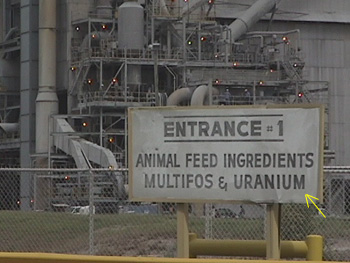
Phosphate ore can contain high concentrations of uranium, as evident by this sign at IMC Agrico’s plant in Polk County.
While uranium, and its decay-products, naturally occur in phosphate ore, their concentrations in the gypsum waste, after the extraction of soluble phosphate, are up to 60 times greater.
The gypsum has therefore been classified as a “Naturally Occurring Radioactive Material“, or NORM waste, although some, including the EPA, have questioned whether this classification understates the problem. According to the Tampa Tribune, the gypsum “is among the most concentrated radioactive waste that comes from natural materials.”
It is so concentrated, in fact, that “it can’t be dumped at the one landfill in the country licensed to take only NORM waste.”
Thus, according to US News & World Report, the EPA is currently “weighing whether to classify the gypsum stacks as hazardous waste under federal statutes, which would force the industry to provide strict safeguards” (to nearly 1 billion tons of waste).
One of EPA’s main concerns with gypsum stacks centers around the fact that radium-226 breaks down into radon gas. When radon gas is formed, it can become airborne, leading to potentially elevated exposures downwind of the stacks. Such airborne exposures are of particular concern to areas like Progress Village, Florida, where “a new gypsum stack is rising a few hundred yards from a grade school.” According to US News & World Report, there is evidence to suggest cancer rates downwind of the stacks may be elevated:
“Some epidemiological studies suggest that lung cancer rates among nonsmoking men in the phosphate region are up to twice as high as the state average. Acute leukemia rates among adults are also double the average. An industry-sponsored study of male phosphate workers, however, found lung cancer rates no higher than the state average. There is no proof that mine wastes cause cancer, but the evidence is worrisome.”
10. Will radioactive gypsum be added to roads?
With the growing realization that gypsum stacks represent a serious environmental threat to Central Florida, both now and for generations to come, the phosphate industry has been looking into ways of reducing the size of the stacks (and the size of their liability.)
In an interesting parallel to fluoride, the phosphate industry is looking to turn its gypsum waste into a marketable product: as a potential cover for landfills, as a soil conditioner, and as a base material for roads.
According to Robert Vanderslice, head of Phosphate Management for Florida’s Department of Environmental Protection, the gypsum is a “good material to replace lime rock in roads. Lime rock will run out at some time, and we’re still building a lot of roads. Building roads with phosphogypsum would consume quite a bit of gypsum.”
In 1995, a “Phosphogypsum Fact-Finding Forum” organized by the Florida Institute of Phosphate Research, presented a “message aimed straight at Washington: Relax the rules on using gypsum and the mountains will gradually disappear.”
As of yet, however, the EPA does not appear willing to relax its rules and lift its ban on commercial uses of gypsum. According to the Tampa Tribune, “EPA’s limit for use is 10 picocuries of radium per gram, well below the levels usually found in the mounds.”
A recent statement from the EPA reads:
“Only two uses (for the gypsum) are permitted: limited agricultural use and research. Other uses may be proposed, but otherwise the phosphogypsum must be returned to mines or stored in stacks.”
11. Commercial Uranium Production
While the presence of uranium decay-products makes gypsum a tough sell for the phosphate industry, the uranium has, at various times, presented the industry with a business opportunity of its own.
One of the lesser-known-facts about the phosphate industry is that its processing facilities have produced and sold sizeable quantities of uranium.
In 1997, just two phosphate plants in Louisiana produced 950,000 pounds of commercial uranium, which amounted to roughly 16% of the domestically produced uranium in the US.
In 1998, the same two plants produced another 950,000 pounds, but due to declining market prices for uranium, both plants have since ceased production.
If market prices improve, however, 4 US phosphate plants (2 in Louisiana & 2 in Florida) would have the capacity to produce a combined 2.75 million pounds of uranium per year, according to the Department of Energy (DOE). The DOE has termed these 4 facilities “Nonconventional Uranium Plants.”
12. Cold War Secrets & Worker Health
The Department of Energy has not always been so open about the uranium-making potential of the phosphate industry. During the Cold War, its predecessor institution, the Atomic Energy Commission (AEC), kept this fact closely under wraps – even to the workers who were, unknowingly, handling large quantities of the radioactive material.
In Joliet, Illinois, it has only recently come to light that the local phosphate plant had secretly produced some 2 million pounds of uranium for the US government in the years 1952 to 1962. According to local newspaper reports, the cancer rates of people who worked at the plant, especially “Building 55” where the uranium was processed, are unusually high.
“We used to kind of joke that if you worked for Blockson, you got cancer,” quipped Vince Driscoll, the son of a cancer-stricken worker.
Today, with the Cold War over, it is becoming clear that workers in the phosphate industry need special protection. According to a report from the European Commission:
“Processing and waste handling in the phosphate industry is associated with radiation levels of concern for workers and the public. The level of protection for these groups should be more similar to the level of protection that is state of the art in other industries, particularly the nuclear industry.”
13. Wastewater Issues
While the radioactivity of the gypsum stacks has probably been the key health concern of the EPA, it is not the only one.
Resting atop the phosphate industry’s gypsum piles are highly-acidic wastewater ponds, littered with toxic contaminants, including fluoride, arsenic, cadmium, chromium, lead, mercury, and the various decay-products of uranium. This combination of acidity and toxins makes for a poisonous, high-volume, cocktail, which, when leaked into the environment, wreaks havoc to waterways and fish populations. As noted by the St. Petersburg Times, “Spills from these stacks have periodically poisoned the Tampa Bay environs. ”
One spill, in 1997, from a now-defunct gypsum stack in Florida, “killed more than a million fish.”
“Strike the Alafia River off your list of fishing spots,” wrote one journalist after the spill. “It’s gone, dead as a sewer pipe, killed by the carelessness of yet another phosphate company.”
Today, the same gypsum stack which caused this particular spill, is considered by Florida’s Department of Environmental Protection to be “the most serious pollution threat in the state.” That’s because tropical rains over the past couple of years have brought the wastewater to the edge of the stack’s walls.
As noted by the Tampa Tribune, “The gypsum mound is near capacity, and a wet spring or a tropical storm could cause a catastrophic spill.”
To prevent such a spill, which was all but inevitable, the EPA recently agreed to let Florida pursue “Option Z“: To load 500-600 million gallons of the wastewater onto barges and dump it directly into the Gulf of Mexico.
The dumping of the wastewater into the Gulf represents the latest in a series of high-profile embarrasments for Florida’s phosphate industry; one of the most dramatic of which happened on June 15, 1994.
On that day, a massive, 15-story sinkhole appeared in the middle of an 80 million ton gypsum stack. The hole was so big that, according to US News & World Report, it
“could be as big as 2 million cubic feet, enough to swallow 400 railroad boxcars. Local wags call it Disney World’s newest attraction — ‘Journey to the Center of the Earth.'”
But, as US News noted,
“there’s nothing amusing about it. The cave-in dumped 4 million to 6 million cubic feet of toxic and radioactive gypsum and waste water into the Floridan aquifer, which provides 90 percent of the state’s drinking water.”
And so it goes. As summarized by the Tampa Tribune:
“It’s not like you can padlock the doors and walk away. The complexities of keeping a phosphate processing plant operating are becoming clear to government regulators now overseeing two of them. Ponds full of 1.5 billion gallons of acid and three mountains of radioactive waste mean you just can’t shut off the machinery and turn out the lights. The state could be stuck with the plants for years. And taxpayers would be stuck with the tab.”
Photographs of the Phosphate Industry
Photographs of the Photographs of the phosphate industry are available here.
References
Full-text copies of all newspaper articles cited in this article can be accessed by clicking on the links within the text. Additional newspaper articles on the phosphate industry can be accessed here. The references for the other cited documents in this article are as follows:
Bellack E, Baker RJ. (1970). Fluoridation chemicals – the supply picture. Journal of the American Water Works Association 62: 223-224.
Coplan MJ, Masters RD. (2001). Silicofluorides and fluoridation. Fluoride 34(3): 161-220.
Denzinger HF, et al. (1979). Fluorine recovery in the fertilizer industry – a review. Phosphorus & Potassium Sept/Oct: 33-39.
Ender F. (1969). “The effect of air pollution on animals.” pp. 245-254. In: Air Pollution – Proceedings of the First European Congress on the Influence of Air Pollution on Plants and Animals, Wageningen, April 22 to 27, 1968. Centre for Agricultural Publishing & Documentation, Wageningen.
Hirzy JW. (2000). Video-taped interview with Dr. J. William Hirzy, Senior Vice President, EPA Headquarters Union. Interview by Michael Connett. July 3.
Hodge HC, Smith FA. (1977). Occupational fluoride exposure. Journal of Occupational Medicine 19: 12-39.
Lillie RJ. (1970). Air Pollutants Affecting the Performance of Domestic Animals: A Literature Review. U.S. Dept. of Agriculture. Agricultural Handbook No. 380. Washington D.C.
Masters R, et al. (2000). Association of Silicofluoride Treated Water with Elevated Blood Lead. Neurotoxicology 21(6): 1091-1099.
Masters RD, Coplan M. (1999). Water treatment with Silicofluorides and Lead Toxicity. International Journal of Environmental Studies 56: 435-449.
Shupe JL. (1970). Fluorine toxicosis and industry. American Industrial Hygiene Association Journal 31: 240-247.
Urbansky ET, Schock MR. (2000). Can Fluoridation Affect Water Lead(II) Levels and Lead(II) Neurotoxicity? United States Environmental Protection Agency (EPA), Office of Research and Development, National Risk Management Research Laboratory, Water Supply and Water Resources Division, Cincinnati, Ohio.
Weinstein LH. (1983). “Effects of Fluorides on Plants and Plant Communities: An Overview.” pp. 53-59. In: Shupe JL, Peterson HB, Leone NC, (Eds). Fluorides: Effects on Vegetation, Animals, and Humans. Paragon Press. Salt Lake City, Utah.
Westendorf J. (1975). The kinetics of acetylcholinesterase inhibition and the influence of fluoride and fluoride complexes on the permeability of erythrocyte membranes. Ph.D. Dissertation in Chemistry, University of Hamburg, Germany.


